Draeger Dolphin Modifications
for Deep, Cave, and Trimix, semi-closed
and closed-circuit
rebreathers
REMEMBER
REBREATHERS CAN AND DO KILL!
IF YOU ATTEMPT TO
MAKE MODIFICATIONS
TO YOUR SYSTEM, YOU DO SO AT YOUR OWN RISK. YOU HAVE BEEN WARNED.
The journey begins
here:
Very early on it was obvious that the standard unit wasn't going to
be adequate for the
diving we do. We tried several configurations of the Draeger unit
trying to address
our concerns. None of them addressed our concerns for deep (75
msw (240 ffw)) or
cave penetrations. My dive buddy Steve Parker came up with the
aluminum mounting
unit with switchblock and I made some turtle shells. The pictures
below illustrate
the results as well as further developments. There are two of
these units. In
semi-closed mode they have been used down below 60 msw (200 fsw) and
for 2+ hr cave
penetrations. They have been used with both nitrox and trimix and
in a wide range of
temperatures. (0C to 30C) Our main concerns all along have been
that most SCR and
CCR units out on the market do not offer adequate OC bailout capability
from deep dives
and are frowned on by the cave diving community in Florida. Our
first major
modification was for a SCR system that met our safety concerns.
|
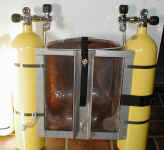
Basic modification - Dual 45 w/crossover and
homemade turtle shell
|
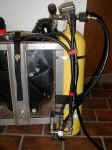
Switchblock for oxygen deco CCR. Oxygen is carried as a
40 cf. (6 l) stage with quick disconnect
|
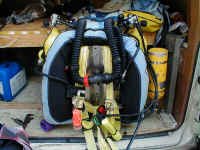
Unit is used with standard backplate assembly. Cylinder on
right is argon suit inflation. On the later unit this is the
oxygen supply for the doCCR.
|
There are a number of individuals around the world who are doing
major modifications to
the Draeger Dolphins and Rays. It seems most are interested in
either changing the
depth range or duration limits of their units. I would like to
mention a few of them
here. Kerry McKenzie of Australia, Jean Michel Urbani of France,
Peter Kruze of
Germany have all had some good input in the exchange of ideas for the
search of the
perfect affordable safe rebreather.
The approach a lot of us have taken is the dual orifice closed
circuit rebreather along
the lines of Gordon Smith's KISS rebreather. Why go
the the KISS
approach?
Well Dave Thompson, original designer of the Inspiration CCR,
put it very
well. He said; "The bad thing about manual CCR's is you
"need"
to drive them, and to a degree that's task loading... The
good thing is you
KNOW that if you don't, you will die. It focuses the mind.
The good thing about electronic CCR's is you don't need to do
anything because they
drive themselves. The bad thing about electronic CCR's is they MIGHT go
wrong, and you
MIGHT not notice it because you don't need to do anything right!!!!"
I believe that from a philosphical point of view it is better to
accept the limitations
and task loading of a manual CCR to gain the experience and intimate
knowledge of your
metabolic needs. Then, if you wish to proceed beyond the
limitations of a manual
sytem, you can invest in an electronically controlled system. You
will have most of
the experience and knowledge to subconsciencally monitor the automatic
systems functions.
When does a Draeger Dolphin cease to be a Dolphin? Well it has
to be sometime
between jettisoning the Draeger BCD and going closed circuit. I
now own a closed
circuit rebreather made up of Dolphin pieces.
I converted mine in september of 2001 and it has gone through
several modifications
since then. These modifications are very impressive to
dive. The first
modification was to install a manual O2 injection valve. This was
first tried by
Kerry McKenzie. This works well, but takes a great deal of
attention to dive.
The second mod was to add a supply line for the O2 to the injection
block for a continuous
supply O2 via the O2 orifice at a reduced pressure and using a constant
pressure
regulator. This allows a low O2 feed insufficient to maintain
metabolism but enough
to cut down in the frequency of manual addition. This is the
principle used by the
KISS rebreather.
|

Manual O2 add valve
|

Detail of CCR mod KISS/McKenzie first
generation CCR
|

Dual orifice CCR (DOCCR) 2nd generation
CCR
|
You can follow the natural progression in the search for the perfect
rebreather.
The second modification was the development of the dual orifice CCR
(doCCR). It uses
the existing Draeger orifices (as before) but mounted on the
switchblock assembly.
The output of the orifices then feeds a common line to the exhaust
(input) side of the
scrubber. This allows a better mixing of the oxygen with the
normal flow of gas
through the loop. The third step was the elimination of the
Draeger orifices and
replacing them with commercial units for a more compact package and the
ability to get to
the 70 m range with sonic flow. To do this a smaller orifice than
the Draeger O2
(pool) orifice was needed. The units I used are from Bird Precision and have dual
40 micron filters.
I am using two oxygauges for PO2
monitoring. (Jump
on the link for a paper on why I settled on two sensors)
Oxygen for the unit is supplied by a 13 cf. (2l) pony bottle
strapped to the side of
the dual cylinders. This is enough O2 for over 5 hrs with
reserve. Argon, when
needed is a 8 cf. (1 l) bottle strapped to the other side.
|

Close-up of switchblock and Draeger orifices with adapters
|
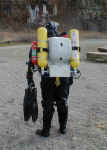
Cylinders upside down. Can reach all
valves easily
|

Closeup of switchblock with Bird Precision
Orifices. More compact Third generation CCR
|
|

Oxygen injection unit fourth generation
|
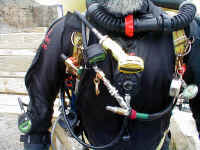
Closeup of connectors and O2 injection.
Fourth generation CCR.
|
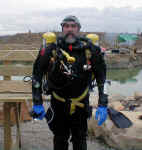
Fourth generation - cleaner left side for
offboard deco gases
|
With the fourth generation, I have eliminated the
switchblock and
installed some stainless hydraulic connectors. These give the
possibility to switch
diluent gases on the fly. The hoses are both color coded and
mechanically
identifiable as to content. The switchblock worked well but
cluttered my side and
was not easily visible. The connectors have restored a fuzzy
feeling I like when I
dive. I have added another page which gives detail pictures of
the Generation 5 unit.
I have also made a second stronger turtle shell for
intermediate depth
diving. It has been dove with the normal 4 l (30 cf.) cylinder
and a 1,8l (13 cf.)
oxygen supply. We plan on adapting this to a configuration very
similar to Kerry's
unit except with 4 l (30 cf.) cylinders for diluent and O2
supply. Depth range for
this configuration is approx. 45 msw with durations of less than 10
mins O2 deco.
Carrying an extra 4 l cylinder in the normal butt mount will extend the
deco limits.
All the designs have been made with the OC bailout worst case scenario
as a primary
consideration. The advantage of this setup is it is
lighter. In a two day
period I managed 5 1/2 hours dive time and never changed a
cylinder! Depths ranged
from 15 - 25 msw. What a great way to dive!!!
|

mod for any backplate BC
|
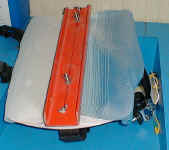
|
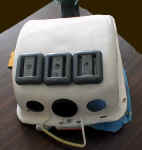
|
|

weight - min 8 lbs for CL's
|
|
|
And now the diving. We would never have had to go to these
extremes if we dove as
my wife prefers, warm and shallow. Well the pics kind of show
what we have to dive.
I say have to dive because diving is an addiction.
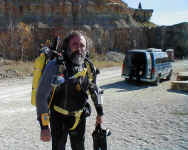 |
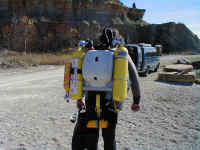 |

Getting out from an ice dive
|
|
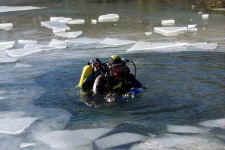
|

|
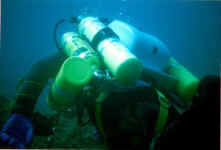 |
|
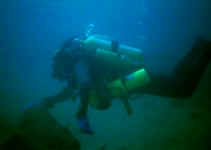
Just a fun dive
|
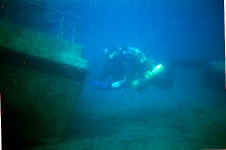
Just fun
|
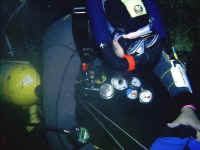 |
























